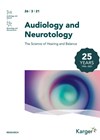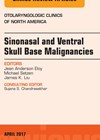
Journal Reviews
Robotic insertion of electrode array in cochlear implantation
Cochlear implants (CIs) are commonly used for profound bilateral hearing loss. They have specific national guidance for their insertion, however patients with a substantial residual acoustic hearing are potential CI candidates. Preservation of this residual hearing can be sought with...
Robotic surgery for ventral skull base malignancy
The use of transoral robotic surgery (TORS) in the head and neck area has been shown to be a safe and effective technique, achieving good oncological clearance of the oropharynx, hypopharynx, supraglottis and glottic area. However, robotic surgery for the...
Outcome of TORS to tongue base and epiglottis in patients with OSA intolerant of conventional treatment
The use of transoral robotic surgery (TORS) in ENT is rather controversial, but the use of robotic surgery for obstructive sleep apneoa (OSA), makes it doubly so. Previous studies on TORS in OSA have been performed with other types of...
In the future there will be robots
This edition of review articles encompasses the emerging techniques of robotic surgery, written by international experts from centres that are increasing their repertoire of procedures. The treatment of oropharyngeal cancer is challenging irrespective of modality, as oncological and functional outcomes...









